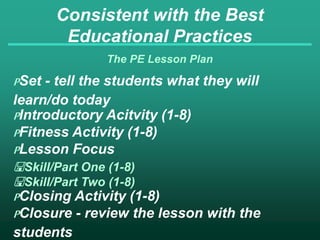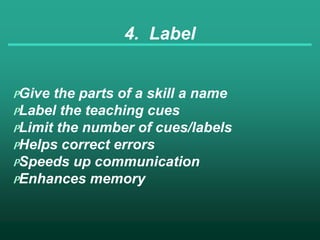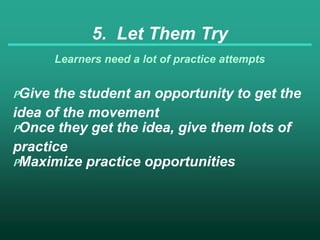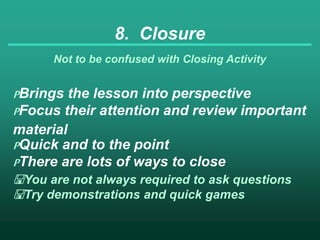8steps in good teaching
- 1. Eight Steps in Good Teaching
- 2. Consistent with the Best Educational Practices The PE Lesson Plan PSet - tell the students what they will learn/do today PIntroductory Acitvity (1-8) PFitness Activity (1-8) PLesson Focus <Skill/Part One (1-8) <Skill/Part Two (1-8) PClosing Activity (1-8) PClosure - review the lesson with the students
- 3. Consistent with the Best Educational Practices The Six Point Lesson Plan <Each of the 6 points has at least one corresponding element in the 8 steps <The difference is in the details
- 4. The Eight Steps in Good Teaching
- 5. 1. Set PAnticipatory Set PFocus and Review PASet the Stage@ - tell the students what they are going to do now PQuick and to the point
- 6. Steps 2 - 4 SHOW, Tell, and Label Are interchangeable POf the three, Show is the most important
- 7. 2. SHOW Show where and how PDon=t just tell PBeginning teachers talk too much PA picture is worth a thousand words PUse a demonstration PWalk students through the drill or game
- 8. 3. Tell PTell the students how/what to do while you show them PKeep it short <Text says 30 seconds <I will allow 2 minutes maximum for very detailed explanations <If doing something that takes longer sit them down for a lecture BWarning, don=t lose their warmup
- 9. 4. Label PGive the parts of a skill a name PLabel the teaching cues PLimit the number of cues/labels PHelps correct errors PSpeeds up communication PEnhances memory
- 10. 5. Let Them Try Learners need a lot of practice attempts PGive the student an opportunity to get the idea of the movement POnce they get the idea, give them lots of practice PMaximize practice opportunities
- 11. 6. Observe Performance PAActive Supervision@ not APassive Supervision@ PMove around and give feedback PMove with a purpose
- 12. 7. Give Feedback PPraise - When you catch them doing something right PRedirect - When a child can=t do the skill PReprimand - When a child won=t try <Don=t confuse a Acan=t@ with a Awon=t@
- 13. 8. Closure Not to be confused with Closing Activity PBrings the lesson into perspective PFocus their attention and review important material PQuick and to the point PThere are lots of ways to close <You are not always required to ask questions <Try demonstrations and quick games













